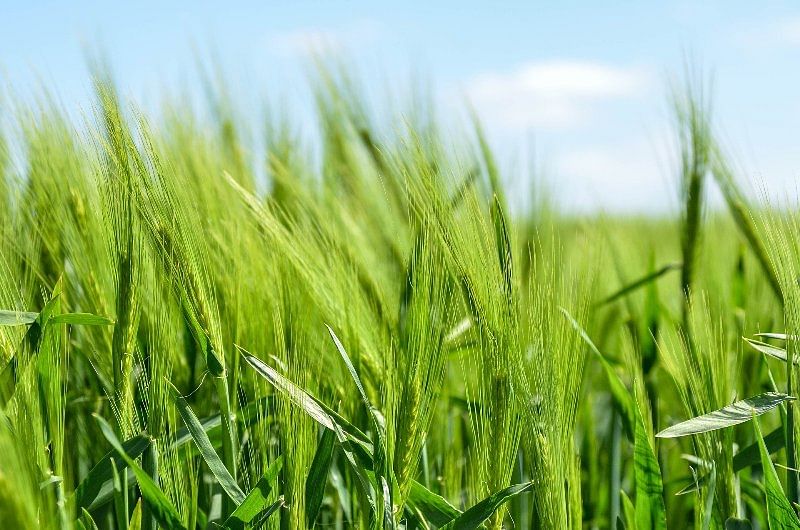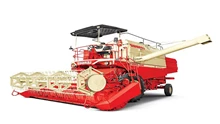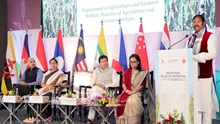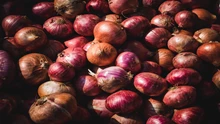
Common name: Jau (in Hindi)
Scientific name: Hordeum vulgare L.
Family: Poaceae
Introduction: Barley (Hordeum vulgare L.) is the fourth important cereal after rice, wheat & maize in terms of total production in the world.
Barley (Hordeum vulgare L.) is frequently being described as the most cosmopolitan of the crops as it is grown over a wide environmental range than any other cereal.
It has been considered, as a “poor man’s crop” because of its low input requirement and better adaptability to harsh environments, like drought, salinity and alkalinity, and marginal lands.
Barley has auspicious use too. It is called Kanak. Buying Barley brings wealth and prosperity during Dhanteras.
The cultivated barley is an annual grass and grown as a rabi crop in Indian plains with a crop duration of 130-150 days.
Genome of Barley is sequenced completely by a group of 77 scientists worldwide. The Research is being done at the University of California.
Barley Producing States:
Barley area, production and productivity in major barley growing states (2018-19)
|
State |
Area (000ha) |
Production (000 tons) |
Productivity (q/ha) |
|
Rajasthan |
225.9 |
812.0 |
35.97 |
|
U.P. |
151.0 |
455.4 |
30.16 |
|
M.P. |
83.0 |
164.0 |
19.81 |
|
Haryana |
14.9 |
57.6 |
38.66 |
|
Punjab |
6.8 |
25.5 |
37.47 |
|
Bihar |
14.3 |
28.4 |
19.9 |
|
H.P. |
20.4 |
36.0 |
17.7 |
|
Uttrakhand |
23.0 |
32.8 |
14.24 |
|
Maharashtra |
25.4 |
11.8 |
4.65 |
|
J & K |
6.4 |
4.21 |
6.55 |
|
West Bengal |
0.7 |
0.7 |
15.17 |
|
Others |
8.4 |
6.2 |
7.3 |
|
All India |
575.6 |
1633.0 |
28.37 |
Barley crop farming is done in 100+ countries worldwide. The total area harvested each year is around 50 ~ 80 million ha and ranked 4th after wheat (~200 million ha), rice (120 ~150 million ha), and corn (100 ~150 million ha).
Climate Required:
Barley is a Rabi crop in India.
The ideal temperature for germination is 12-25oC. The temperature required for growth is between 12 degrees Celsius and 16 degrees Celsius.
At the time of barley crop harvest, the grain moisture should be around 13-14 % which is achieved at the temperatures of 30-32oC at the end of maturity. The barley is quite a hardy crop and grows from the higher Himalayas to Rajasthan, thriving in normal, sodic, and alkaline soils. It can be grown as an irrigated crop with 2-3 irrigations and under rainfed conditions.
The timely sown feed and malt barley is sown between 1-25 November and in the case of late sown crop it is 1-25 December.
Soil Required:
Barley crop farming can be done on a variety of soil types, however, sandy to moderately heavy loam soils of Indo-Gangetic Plains having neutral to mild saline reaction and medium fertility are the most suitable types for barley cultivation. Having better salt tolerance barley is also grown in saline areas of various states. In drought affected areas also barley is crop of choice among cereals due to low input requirements especially water and nutrients.
Mode of Propagation:
Barley crop is propagated through seeds once the dormancy period is over. The dormancy period varies from 30-60 days depending upon the variety.
Barley Sowing Process:
Soil preparation:
Field is prepared with disc harrow and cultivator then planking is done. Land levelling is very important as barley crop is very sensitive to excess water and nitrogen. Appropriate bunding of field is essential for proper irrigation. In case of irrigated barley cultivation, pre-sowing is essential for proper germination.
Barley Seed treatment
-
For management of Loose Smut, seeds should be treated with Bavistin or Vitavax @ 2gm/kg seeds.
-
The covered smut can be controlled by seed treatment with 1:1 mixture of Thiram + Bavistin or Vitavax @ 2.5 gm/kg.
-
If termite problem is observed in fields, treat the seed with 150 ml Chloropyriphos (20EC) or 250 ml Formathion (25EC) in 5-liter water for 100 kg seeds to avoid the loss due to termite attack.
Barley sowing method:
The best sowing method is line sowing through seed drill. Some farmers also use a “chonga” fixed on a traditional plough to drop seeds.
Barley seed spacing for timely sowing is 23 cm, for malt barley it is 18-20 cm and for late sowing is 18-20 cm.
Weed management:
Barley is a fast-growing crop and generally weed problem can be avoided if proper crop stand is maintained.
-
For narrow leaf weeds Pinoxidin (Axial 5 EC) should be used at the dose of 350 ml in 120 liters of water for one acre at 30-35 days after sowing.
-
For broad leaf weeds Metsulfuron (Algrip) 8 g in 120 liters of water for one acre at 30-35 days after sowing. Another weedicide is 2,4-D at the rate of 500 ml in 120 liters of water for one acre after 30-35 days of sowing.
For both broad leaf and narrow leaf weeds Isoproturan (Iso Guard 75 WP) 500 g in 120 liters of water for one acre 30-35 days after sowing. The Pendimethalin (Stomp) can be used at the dose of 1.2 liter to 1.5 liter per acre in 120-150 liters of water for one acre after 1-3 days after sowing.
Irrigation Requirement:
Barley crop can be grown in irrigated, limited irrigation and rainfed conditions depending upon the area of cultivation. Specific varieties are there for different conditions. Barley normally requires 2-3 irrigations.
Give:
-
1stirrigation at 25-30 days after seed sowing (when crown root initiates)
-
2ndirrigation at 65-75 days after seed sowing (when panicle emerges)
-
3rdat 90-95 days after sowing during grain formation stage.
Fertilizers:
Mainly Nitrogen (N), Phosphorus (P) and Potassium (K) are required for Barley crop. It is always better to get soil health card of the field for better management of nutrients.
Requirements:
-
For timely sown irrigated crop, 60 kg/ha of N, 30 kg/ha of P and 20kg/ha of K.
-
For late sown irrigated crop, 60 kg/ha of N, 30 kg/ha of P and 20kg/ha of K.
-
For malt barley, 80 kg/ha of N, 40 kg/ha of P and 20kg/ha of K.
-
For rainfed crop in plain region, 30 kg/ha of N, 20 kg/ha of P and 20 kg/ha of K.
-
For rainfed crop in hilly region, 40 kg/ha of N, 20 kg/ha of P and 20kg/ha of K.
For irrigated crop, apply ½ N, full P and K as basal application. Apply the other ½ N as top dressing after 30 days of sowing or 1st irrigation. For rainfed crop full dose of NPK is given as basal dose.
The fertilizer application should be based upon soil health card and in case of Zn deficiency, apply ZnSO4 as 8 kg per acre. Application of other micronutrients should be done based upon soil testing/deficiency symptoms.
Pest & Diseases:
Major diseases of barley crop are Loose Smut, Covered Smut, Rusts and blight. Among the pest’s aphids may cause considerable damage if not controlled. In some areas of Rajasthan and Haryana Molya disease (caused by cereal cyst nematodes) also occurs.
The occurrence of disease takes place due to the use of non-resistant varieties, weather conditions and area of cultivation. Therefore, always improved varieties with disease resistance should be used. A few pests and diseases can be controlled through seed treatment. For others, you must contact your nearest agricultural department for the management of diseases and pests.
Harvesting:
Barley crop gets ready for harvest by the end of March to first fortnight of April in different areas. Barley spikes are susceptible to shattering, therefore crop should be harvested when it matures to avoid breakage of spikes due to dryness on over maturity and in case of harvest with combines to avoid grain breakage.
Yield:
Average yield of barley may vary from 8 to 15 quintals per acre depending upon the area, variety, cultural practices and prevailing weather conditions.
Storage:
Barley grains are prone to absorption of environmental moisture thus the crop should be stored in dry places to avoid storage pest losses
Barley Cost of Production:
|
State |
Cost of Cultivation (Rs. /hectare) |
|
Rajasthan |
25004 |
|
Uttar Pradesh |
22338 |
|
Himachal Pradesh |
21893 |
Barley Uses:
-
Barley grain is mainly used as animal feed (65-70 %), malt for industrial uses (25-30%), and directly as human food (around 2%).
-
Barley straw is used as animal feed either directly fed to the animal or used for silage.
-
Green leaves are also used as green forage in the areas where other forage crops cannot be grown.
-
Malt is the second largest use of barley and malting barley is grown as a cash crop.
-
The utilization of barley for the malting and brewing industry has picked up recently with an increase of consumption of beer and other malt-based products in many countries including India.
-
Barley has been recognized as a functional food and is part of some multigrain products. In India, its utilization as a food crop (mainly hull-less type) is restricted to the tribal areas of hills and plains.
-
The barley products like “Sattu” and “missi” roti have been traditionally used in India.
-
Barley is used as medical imaging drink at University of Buffalo.
Source: USDA National Nutrient Database for Standard Reference (Release April 2018)
Complex carbohydrate is discovered in Barley research that is going on for 30 years.
Know about Pradhan Mantri Fasal Bima Yojana when you decide to do barley crop farming.
Better quality should be used to get better productivity and can be obtained from Nation Seeds Corporation / State Seeds Corporation/Research Institution or Agricultural Universities.
Co-author:
Gyanendra P Singh, FNAAS, FISGPB, FSAWBR
Director, Indian Institute of Wheat & Barley Research
Karnal-132 001, India
Email: Official: director.iiwbr@icar.gov.in, gp.singh@icar.gov.in;
Cell: +919868841775, +918708529619 Web: www.iiwbr.org










